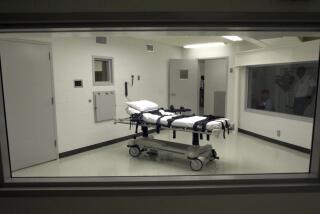California proposes new lethal injection procedures
State corrections officials Tuesday proposed new lethal injection procedures, a first step toward resuming executions in California after a four-year halt.
The proposals involve only minor changes to the three-drug method used on 11 of the 13 men put to death in the state since capital punishment was reinstated in 1976.
But the revisions appear to address the concerns of a federal judge who deemed the previous lethal injection practices unconstitutional for their risk of inflicting cruel and unusual punishment.
The California Department of Corrections and Rehabilitation issued the proposed changes in a 25-page draft and announced a 15-day period for public comment. Once any additional revisions are made and the new protocols adopted, the execution procedures must pass judicial review for their conformance with state law and the U.S. Constitution.
California has the nation’s largest death row, with 697 inmates sentenced to die. The last execution was in January 2006, when convicted killer Clarence Allen was put to death by lethal injection at San Quentin State Prison.
When murderer Michael A. Morales was scheduled to die a month later, U.S. District Judge Jeremy Fogel of San Jose intervened to impose conditions that led to the current moratorium. Fogel later ruled the state procedures constitutionally flawed after hearing testimony that some of those executed may not have been fully anesthetized by the first injection before receiving the second shot, a paralyzing agent, and the painful last dose that stops the heart.
Gov. Arnold Schwarzenegger convened a task force in 2007 to revise the lethal injection procedures to ensure they were administered effectively. But those changes were adopted behind closed doors and without public input, prompting Marin County Superior Court Judge Lynn O’Malley Taylor to rule them illegal and in violation of the state’s Administrative Procedures Act.
Corrections officials last year published the proposed changes and sought public comment, drawing more than 8,000 e-mails, letters and statements. Tuesday’s proposed revisions incorporated some of the public’s concerns, including clearly delineated areas for execution witnesses and access to the condemned prisoner’s holding cell for chaplains and spiritual advisors.
Once corrections officials formally adopt the protocols and the state Office of Administrative Law approves them, Taylor and Fogel will evaluate them for compliance with state and federal law.
Experts predict that the legal reviews will take months, but that executions could resume as soon as this year if the changes put to rest the judges’ concerns.
More to Read
Sign up for Essential California
The most important California stories and recommendations in your inbox every morning.
You may occasionally receive promotional content from the Los Angeles Times.











